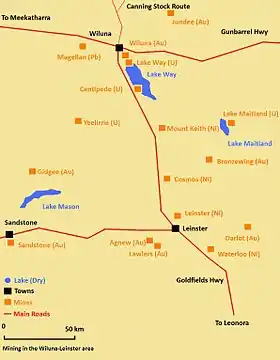Sandstone Gold Mine
The Sandstone Gold Mine is a gold mine located 6 km south east of Sandstone, Western Australia.
| Location | |
|---|---|
 Sandstone Gold Mine Location in Australia | |
| Location | Sandstone |
| State | Western Australia |
| Country | Australia |
| Coordinates | 28°00′S 119°17′E |
| Production | |
| Production | 29,885 |
| Financial year | 2009-10 |
| History | |
| Opened | 1990 |
| Closed | 2010 (scheduled) |
| Owner | |
| Company | Troy Resources |
| Website | www |
| Year of acquisition | 1999 |
It is currently owned by Troy Resources. While not a particularly large mine, Sandstone has been very profitable for Troy in the past, having been the lowest-cost gold producing mine in Australia in the early 2000s.[1]
History

Gold mining at the Sandstone area stretches back over the past century. In 1894 a prospector discovered gold about 20 km south of present-day Sandstone and, in 1903, gold was found within a few hundred meters of the town. From 1903 to 1916, 930,000 ounces of gold were mined in town. With the outbreak of the First World War, the fortunes of the mine, and the town, declined and the population in Sandstone fell from a high of 8,000 in 1906 to approximately 200 in 1919.[2]
The current incarnation of the mine however dates back to 1990, when Herald Resources Limited begun milling operations. In 1999, Troy took ownership of the operations.[3]
Troy commenced production at the Bulchina mine at Sandstone in 2002, which lasted until early 2005 and produced 223,000 ounces of gold.[3] The company discovered two more gold deposits in the Sandstone region in 2004, the Lord Henry and the Lord Nelson deposits, located approximately 30 kilometres south east of Bulchina.[4]
Mining commenced at the Lord Nelson deposit in early 2005 and at the Lord Henry deposit a year later. The Company upgraded the Sandstone milling facilities in early 2005 to be able to process 600,000 tonnes per annum.[4]
In January 2009 it was announced that the Sandstone operation, which was to close in February that year, would remain active because of higher gold prices, which made processing low grade ore from Lord Nelson more profitable.[5] The mine is now scheduled to close in September 2010.[6]
Production
Production of the mine:
| Year | Production | Grade | Cost per ounce |
| 1998[7] | 34,330 ounces | 2.39 g/t | A$277 |
| 1999[7] | 9,952 ounces | 1.41 g/t | A$365 |
| 1999-2000[8] | 47,803 ounces | 5.48 g/t | A$157 |
| 2000-01[9] | 58,299 ounces | 4.46 g/t | A$145 |
| 2001-02[9] | 46,835 ounces | 3.41 g/t | A$219 |
| 2002-03[10] | 42,895 ounces | 3,29 g/t | A$255 |
| 2003-04[10] | 34,123 ounces | 2.66 g/t | A$415 |
| 2004-05[11] | 19,148 ounces | 1.26 g/t | A$437 |
| 2005-06[12] | 67,934 ounces | 4.52 g/t | A$241 |
| 2006-07 | 90,456 ounces | 5.62 g/t | A$322 |
| 2007-08 | 33,846 ounces | 2.65 g/t | A$706 |
| 2008-09 | 32,930 ounces | 2.1 g/t | A$602 |
| 2009-10[6] | 29,885 ounces | 2.1 g/t | A$1,000 |
Sources
- The Australian Mines Handbook: 2003-2004 Edition, Louthean Media Pty Ltd, Editor: Ross Louthean
- Western Australian Mineral and Petroleum Statistics Digest 2008 Page 34: Principal Mineral and Petroleum Producers - Gold
References
- The Australian Mines Handbook: 2003-2004 Edition, page 530
- Sandstone The Sydney Morning Herald, published: 8 February 2004, accessed: 5 September 2009
- Troy website - Sandstone Archived 13 October 2009 at the Wayback Machine accessed: 5 September 2009
- Troy website - Company history Archived 13 October 2009 at the Wayback Machine accessed: 5 September 2009
- Troy Resources defers closure of Sandstone gold mine industrysearch.com.au, published: 21 January 2009, accessed: 5 September 2009
- Troy quarterly report June 2010 published: 30 July 2010, accessed: 30 July 2010
- The Australian Mines Handbook: 2003-2004 Edition, page 125
- Troy quarterly report June 2000 accessed: 5 September 2009
- Troy quarterly report June 2002 accessed: 5 September 2009
- Troy quarterly report June 2004 accessed: 5 September 2009
- Troy quarterly report June 2006 accessed: 5 September 2009
- Troy 2006 annual report accessed: 5 September 2009
External links
- Place Names Search Results - Sandstone Geoscience Australia website
- Troy website - Sandstone operation